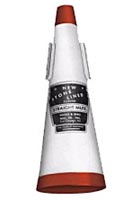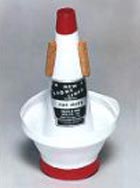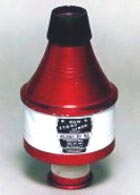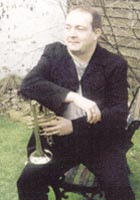Humes and Berg Cornet Mute Review
14-Dec-20034BR has asked Robert Westacott, the current Principal Cornet of the Hepworth Band to "roadtest" 4 mutes from Humes and Berg.
Within the brass band as a whole, but particularly within the cornet section, the use of mutes has now become so extensive that very rarely will you perform a piece without using at least one form of mute.
The range of colours and textures called for by today's composers and arrangers has seen a marked increase in the number of various mutes required. Most cornet players will therefore take up to four mutes on stage with them for any concert or contest performance, these being:
- A fibre straight mute
- A fibre cup-mute
- A metal straight mute
- A harmon mute
As well as these there are various others, such as Bucket mutes and plungers, and for home practice (or quiet passages within test pieces!!) there are practice mutes.
Mutes come in all shapes and sizes, all colours and fabrics. The choice for players is wide and wonderful – some players will buy their own, whilst many bands will at some time or another splash out and get the whole section a full set. The latter is the best course of action as it will give uniformity of sound (just have a look around your own cornet section to see the Heinz 57 varieties on show, and then ask your self why you sound so out of tune), but care must always be taken in purchasing the right mutes for the right job.
Just like anything else in life, you only get what you pay for, and given that you will hope to get at least a decade of service from your mutes, don't go for false economy. Pay for quality and the whole band will hear the difference (and maybe the odd adjudicator!).
One last thing though. Most bands will have a fairly high turnover of players in the cornet section over the years, so if you are going to spend a lot, make sure you use a felt tip pen and mark up your mutes as the property of your band and keep a register of what player has got what. If you do happen to "lose" a player then you can get your hands back on your property and you will keep your hard working band treasurer happy for Christmas.
So which ones do you choose?
4BR has asked Robert Westacott, the current Principal Cornet of the Hepworth Band and someone who has played with many of the very best bands in the country to "roadtest" 4 mutes from Humes and Berg, perhaps the most well known and recognisable mute manufacturer on the market. These are his thoughts on them.
Humes and Berg Stone-Lined mutes were invented in 1935. Willie Berg was a struggling musician working in Chicago, who would tour the local clubs selling valve oil and other supplies to the band members. He befriended a number of famous musicians such as Duke Ellington and Harry James, but his real inspiration came from Glen Miller who encouraged Willie to make mutes for the instruments within his brass section.
I myself have used Stone-Lined mutes for many years, and have been asked to review four of these. The mutes are all manufactured to the same high quality and have the distinctive red & white livery that makes then instantly recognisable as a ‘Stone-Lined' mute.
 Straight Mute (Model HB101).
Straight Mute (Model HB101).
The classic design, and perhaps the most popular cornet mute of all time. This mute is responsive and stable at all dynamic levels, providing a precise crisp tone. The mute is free blowing across the range of the instrument with the exception of the extreme low register where it does require a little more effort.
I found the tuning and intonation of the mute to be excellent with none of the usual adjustments to the tuning slide required.
At higher dynamic levels, the mute responds very well, particularly in the mid-high register. The Stone-Lined straight mute is, in my opinion, a must have item for any cornet player at any level. With straight and cup mutes in particular, it is well worth either buying and using your own mute, or ensuring that you use the same mute from the band's supply. This way the mute corks can be trimmed or filed to fit your instrument. The Stone-Lined straight mute is priced at around £15.00 and is a "must have" item in any cornet players case.
 Cup Mute. (Model HB102)
Cup Mute. (Model HB102)
The Cup-Mute is again responsive across the range. Like the straight mute, on initial purchase the corks will need to be filed to suit the individual instrument. This needs to be done so that the cup section of the mute is close enough to the bell to produce the desired ‘cupped' effect – but not so close that it touches - which produces a distorted sound.
The Stone-Lined mutes, unlike some of their competitors, have a fixed cup. However, this does not detract too much from their usability. The sound produced from a correctly positioned cup-mute is rich across the tonal and dynamic range of the instrument and equally at ease in solo or tutti passages. The intonation of the mute is excellent, with only the lower register requiring some attention if the dynamic level is on the loud side. The Cup itself is big enough to accommodate some judicious "padding" from cotton wool or an old handkerchief if an even softer timbre is required without losing the individual cup mute effect.
The Cup-Mute is priced around £27.00 and again is one that I would recommend is in the case of all cornet players.
 Harmon Mute. – " Wa-Wah Du All" (Model HB111)
Harmon Mute. – " Wa-Wah Du All" (Model HB111)
This is a fantastically versatile mute. The extension tube is excellently manufactured, which allows countless subtle changes in timbre as the tube is extended.
With the tube in the fully closed position, the ‘Wa-Wah' effects are their most prominent. As the tube is gradually extended, the sound of the mute changes and gives almost a ‘Buzz' effect, which, if combined with some ‘Wa-Wah' actions and a bit of flutter tonguing, can make your cornet almost ‘talk' to you! The extension tube can also be completely removed. This allows the performer to achieve a more muffled ‘close up to the microphone' sound, which is very useful for some of the solo lines in the more Swing or Big Band style repertoire.
Again, I found the intonation of this mute to be excellent, and it responds well at all dynamics and across the whole range of the cornet. This type of mute is underused in the brass band, it can be utilised to produce such wonderful timbres, but all too often it is just used for playing very quietly. Brave conductors should utilise it more whilst players should experiment more with it – it will reward a bit of research.
The Wa-Wah Du All" is priced around £45.00, which is good value for money as I am still playing on one that I bought around 10 years ago.
 Sh! Sh! Quiet Mannie Klein Practice Mute. (Model HB132)
Sh! Sh! Quiet Mannie Klein Practice Mute. (Model HB132)
Despite the very strange name, this is an excellent addition to the Humes & Berg Stone-Lined range. This was my first encounter with the Stone-Lined practice mute, and the first thing I noticed was that it doesn't seem to have as much resistance as some other practice mutes on the market. It is free and easy blowing across the whole register. The mute is very responsive and it does produce an extremely clear, but very quiet sound. This makes it an ideal solution for people who want to practice but are in a situation where playing at full volume is not an option.
As with other practice mutes on the market, the intonation does suffer a little, particularly in the high register, but on this mute the affect is not enough to disturb a practice session. Again, this mute is built to the same high standards as the others in this review. I was unable to find a UK retail price, but judging by the $ prices on the Humes & Berg website the mutes should retail at around the same price as the Cup-Mute.
In conclusion, the Stone-Lined range are superbly manufactured – you can feel as well as hear the quality, they are certainly long lasting, user-friendly mutes that are good value for money and add an excellent array of colours to any cornet section. The use of mutes has greatly increased over the last few years to such an extent that they are now essential tools of the cornet players trade. Humes and Berg offer the cornet player from the enthusiast to the professional the tools to enhance their playing, and I can recommend them fully.
Rob Westacott - December 2003.
 Rob Westacott
Rob Westacott
Rob started in Brass bands at the age of 7 under the guidance of his father Ron Westacott. In 1988 he moved up to Manchester to study at University College Salford and received lessons from David King and David James.
In 1988 he joined Black Dyke and spent several years there, including a spell as assistant to Roger Webster.
Rob graduated from Salford in 1991 with a BA(hons) and since then has held seats in most of the top ranking bands in the country.
He has been principal cornet with the Leyland Band, Brighouse & Rastrick, Tredegar and Yorkshire Imps and has featured on many CD and radio recordings as a soloist.
In September 2003 Rob joined the Hepworth band on principal cornet and led the band to their second placing at this years inaugural Scottish Open Championships.









